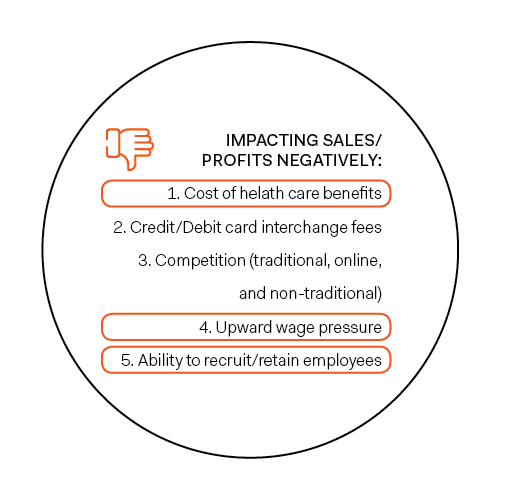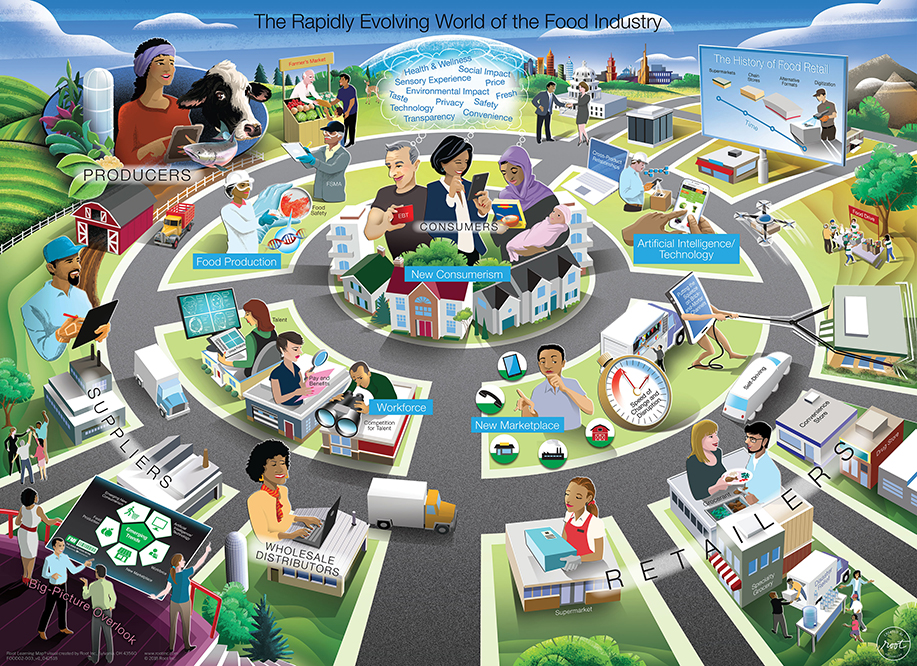In fact, in The Food Retailing Industry Speaks 2019 report, three of the five factors that impacted sales and profits negatively were workforce issues: cost of healthcare benefits, upward wage pressure, and the ability to recruit and retain employees1.

Attracting and Retaining Talent: In the current economic environment, competition for talent is fierce, given the low rate of unemployment and upward pressure on wages. FMI operations data show that 87<percent of food retailers are concerned about the push for higher wages, and 81 percent believe that the low unemployment rate is making recruitment and retention of talent a challenge. For many, working in the food industry is typically a first job, with fewer and fewer choosing it as a career. Filling supply-chain and technology positions has been particularly challenging, given that food retailing is competing for talent with the large, global organizations in the technology field. A strong employee value proposition is essential to help talent see that a career path in the food industry is dynamic, exciting, and an opportunity to do meaningful work in an important field. Higher wages and competitive benefits packages are another way that companies are responding to the talent war. Rising healthcare costs have long been a concern of food retailers, but more recently many have started to see that taking a proactive approach and absorbing those costs is an important step to attract and retain talent.
Attracting and Retaining Talent: In the current economic environment, competition for talent is fierce, given the low rate of unemployment and upward pressure on wages. FMI operations data show that 87<percent of food retailers are concerned about the push for higher wages, and 81 percent believe that the low unemployment rate is making recruitment and retention of talent a challenge2. For many, working in the food industry is typically a first job, with fewer and fewer choosing it as a career. Filling supply-chain and technology positions has been particularly challenging, given that food retailing is competing for talent with the large, global organizations in the technology field. A strong employee value proposition is essential to help talent see that a career path in the food industry is dynamic, exciting, and an opportunity to do meaningful work in an important field. Higher wages and competitive benefits packages are another way that companies are responding to the talent war. Rising healthcare costs have long been a concern of food retailers, but more recently many have started to see that taking a proactive approach and absorbing those costs is an important step to attract and retain talent.
Turnover: While turnover has long been an issue in the food retailing industry, turnover rates hit an all-time high in 2019, at 45 percent overall and 58 percent for part-time workers; though not as high, the rates are on the rise for full-timers and corporate employees, too3. In an environment that has shifted from a customer experience that focused on speed and efficiency to one that is more personalized and experiential, turnover presents an even greater problem than it once did. Companies cannot simply bring talent on board and fill a slot. The situation is much more complex in today’s food retailing environment where learning and onboarding require a significant time investment.
Four Generations at Work: Today’s workforce is alive and humming with four distinct generations, each with their own set of expectations about work. Factors such as their expectations of leadership, development, compensation, healthcare and benefits, and the use of technology to enable their work experience vary across the Baby Boomers, Generation Xers, Millennials, and the newest members of the workforce, Generation Z. Food retailers must be prepared not only to understand, but also to respond proactively to the different needs that the four generations bring to the table.
Many in the food retailing industry are responding to these new workforce trends by shifting their mindset and their focus. In an environment where consumer expectations are deep, vast, and soaring, winning means thinking about and investing in talent in new ways. Whether that’s absorbing increases in healthcare and benefits, paying bonuses, offering health and wellness programs, or giving employees more learning and training opportunities, food retailers can no longer afford not to make workforce and talent a key component of their strategy.
Emerging Trends And The Path Forward
With workforce challenges in the spotlight, one helpful way to think about change is to explore the top four emerging trends in the food retailing industry and to understand how workforce strategies can create a meaningful path forward. Each of these emerging trends – new consumerism, artificial intelligence/ technology, new marketplace, and food production – forms the backdrop for a path forward that focuses on your people, along with key workforce considerations.
Trend #1: New Consumerism
To win in the food retail industry means putting the consumer at the forefront of everything we do and recognizing that their needs will continue to evolve. Technology has shaped a new class of consumers – ones who want a deeper connection with what they eat. Consumers today want awareness and transparency when it comes to when, where, and how their food is produced. They readily use digital means to get information and to shop – staying virtually connected to the food chain.
PATH FORWARD: REINFORCE BIG-PICTURE THINKING
In an era of complex consumer needs, one step food retailers can take is to help workers, regardless of their position, understand the new consumerism and the demands of today’s marketplace. With changes in technology, food production, customer experience, and a reinventing of the way things have traditionally been done, everyone in the business needs to understand why – and the heart of why comes from your consumers.
Building knowledge of these changing needs and of the big picture of the food industry will prime employees to take action instead of adopting the more common response to change – resistance. A combination of visuals, data, and discussion in small teams is a highly effective way to help employees see and understand the big picture. PowerPoint slides and a lecture won’t cut it. To truly grasp the big picture, people need to see, touch, feel, and talk about their experiences. Investing in your people in this way puts everyone in the game together in a way that will accelerate your results.
Key workforce considerations:
- What actions are you taking to help everyone build knowledge about new consumerism? How are you measuring success?
- What is your workforce doing to engage customers in a personal way?
- What are you doing to train, recognize and reward your people for engaging your customers in a personal way?

Trend #2: Artificial Intelligence/ Technology
Advances in technology and the emergence of artificial intelligence have driven change in every corner of the food industry. From how food is grown using water insecticide monitoring, to how it is harvested with robotics, to how it’s transported with driverless trucks and drones to fully automated warehouses and marketed through data collection and social media, to how it is ultimately sold via smart shelves and self-checkout – technology has transformed the industry.
Food retailers have had to become adaptable as new technology amplifies the pace of change. With each new change in technology that food retailers adopt, there’s been a concomitant business-process aspect involving the role of people that cannot be ignored.
PATH FORWARD: REDEFINE JOBS AND CREATE A CONTINUOUS LEARNING MINDSET
Technology such as AI is greatly enhancing food retailers’ ability to improve operations and drive deep consumer insights. While 10 percent of food retailers are using AI today to leverage customer data, 87 percent are using technology to personalize the shopper experience, and 46 percent believe technology will change the in-store shopping experience in the near future. With technology playing a bigger role than ever, food retailers must not ignore the implications that has on people. Jobs are being redefined, as machines automate traditional human tasks. Where just a few years ago AI was simply used for processing information or delivering data, today it is exercising judgment and making recommendations. As this happens, AI and other technologies are becoming more essential to productivity, efficiency, and profits. People working alongside AI and new technology will be impacted by a redefinition of job responsibilities. This integration of machine intelligence and human intelligence represents a new frontier in food retailing, and people must be prepared for the coming shift.
A great example of this is category buyers. AI can make buyers smarter and more accurate than ever before with access to better data. But to take advantage of this capability, buyers must learn to trust the data offered up via machines, rather than relying on former methods, such as gut instinct. This doesn’t mean there isn’t room for human interpretation and validation; instead, it means elevating the real value of the human actor by enabling them to focus on problem solving, communication, and interpretation – higher-level skills that machines cannot replicate.
Technology is no longer simply automating tasks. It is reshaping roles – not just in the present, but as we look to the future as well. Job responsibilities are no longer etched in stone. The role you are hired for won’t look the same in ten years, five years, or even next year. Fueled by technology, the increasing pace of change means we must be prepared for job expectations to change on a regular basis. To be successful, we must adopt a continuous learning mentality and be ready to adapt. This comes with challenges for many. It isn’t as simple as cross-training people. It’s helping them find their way as responsibilities shift. It’s getting them comfortable with new roles and understanding where they can thrive.
And it’s helping them be prepared to adopt new skills that match the changing needs of the business.
Key workforce considerations:
- How are you preparing people for an integrated human/technology environment? Do you know where their pain points are with this transition and how are you addressing them?
- What steps are you taking to create a mindset of continuous learning and adaptability with your people vs. excellence in a single function?
- Do your recruitment practices ensure that you’re hiring people with a change-oriented mindset – who are energized by the opportunity to learn and adapt along with the market changes?
Trend #3: New Marketplace
Food retailing has moved from viewing online and brick and mortar as an either/ or proposition to a both/and solution to giving the consumer what they expect. Taste, convenience, and values must all align with their personal definition of eating well at a price they can afford. Meeting these expectations means that food retailers are rethinking the size, format, style, and location of the physical store and the role it plays in the online strategy.
PATH FORWARD: STRONGER INTEGRATION AND CUSTOMER EXPERIENCE IN AN OMNICHANNEL WORLD
For many food retailers, their online success to date has been achieved via a strategy of separation. Online operations functioned as a separate division where processes, people and promotions ran parallel to the traditional in-store experience. In many cases even the culture, goals, and metrics felt very different. As online operations and consumer expectations of their online and in-store experience have matured, functioning separately is no longer the primary play. This means that food retailers are looking at an integrated omnichannel world – which inside the organization feels a lot like a merger does. Processes need to be redefined, technology needs to be accessed differently, and people need to operate differently. All of this integration requires careful communication with employees at the strategy and job level. People need to understand the omnichannel approach, why it’s necessary to move away from the siloed style of the past, and what aspects of their job are changing because of that shift.
There’s a second layer of complexity that comes with an integrated, omnichannel world: With the convenience and access the online channel allows for buying anything anywhere anytime, consumers now want to get something different out of their in-store experience. Food retailers are reimagining the customer experience, placing greater emphasis on community outreach, setting up store tours to help customers change their eating habits by changing what they shop for, cooking classes, and offering health and wellbeing programs. While the customer experience can be mapped out at the corporate level, it comes to life at the local level. Local store managers and their teams should feel ownership for personalizing the customer experience, so that anyone interacting with customers does so in a meaningful and authentic way.
Key workforce considerations:
- Has your omnichannel strategy been well communicated across your business? Do people understand what’s driving change and why it’s critical to operate differently?
- How does your customer experience play out at the local level? Are store leaders designing for authentic, personal experiences or primarily for price and promotion?
- What are you doing to showcase and reward great examples of personalizing the customer experience at the local level?
Trend #4: Food Production
As our supply of food becomes more diverse and we source products from around the world, the issue of food safety grows in importance. The demand for fresh produce year-round increases our vulnerability, as seen with the number of recalls involving fruits and vegetables.
The role that food retailers play in food production will shift from being the selling agent for the producer to being the buying agent for the customer. They will need to advocate on behalf of consumers or risk losing their trust and loyalty.
PATH FORWARD: CONTINUALLY BUILD KNOWLEDGE
- From a workforce perspective, acting as the buying agent for the customer will require a new level of knowledge of food production and entail the adoption of a new set of processes. Employees will need an in-depth understanding of the products so they are armed with the information consumers seek when make buying decisions. The expectation – and what’s becoming the new normal – is that store associate have expertise in this area. Establishing and maintaining that knowledge is an investment in skill building that food retailers should make.
- Another example of how changes in food production and consumer demand are impacting the workforce is in ready-to-go, fresh meals. As food retailers shift to a central kitchen model, consumers expect the same quality and food safety they find in a restaurant. This represents a major shift in in-store operations, creating job responsibilities that didn’t exist before.
- Whether it’s the need for continuing education about product and food safety or evolving responsibilities in-store, it’s critical that it be easy for employees to access information and ensure they’re adopting those behaviors that align with changing roles.
Key workforce considerations:
- What actions are you taking to ramp up associate product knowledge?
- How are you leveraging technology to build knowledge quickly and deeply?
- As new job responsibilities emerge as a result of changes in food production, what are you doing to ensure important food safety behaviors are adopted?
Turning Workforce Change Into A Competitive Advantage
As we consider emerging trends in food retailing and how to win in the marketplace, it’s apparent that this is a complex story. It’s not just what happens in-store or online – massive changes in technology, operations, supply chain, and marketing are also creating new and diverse workforce challenges. Each emerging trend has implications for the workforce that must be addressed to reinvent, thrive, and realize the changes that food retailers have set in motion. People have to be engaged at a deep level to understand the bigger picture – why every aspect of the business is operating differently today than it did just a few short years ago. They need to be engaged and to recognize why new behaviors and actions are necessary – and be guided by a mindset of continuous learning and adaptability. By recognizing and responding to these trends and their implications, food retailers can accelerate the pace and success of change through the workforce, rather than in spite of it.
Case Studies
Engaging your employees is central to personalizing the customer experience and to setting you apart from the pack. Encoding employee engagement into the organizational DNA is something that can be achieved in different ways, depending on the organization. We’ve put together some case studies showing how food retailers established employee engagement.
KELLOGG’S: OWNING THE OCCASION– REVENUE GROWTH MANAGEMENT
In order to grow, Kellogg’s knew they needed to shift from a product- based sales approach to providing consultative value to their clients. The transition from product-based sales to owning the occasion included both a mindset shift as well as skill development.
Kellogg’s began by engaging employees in the context behind the shift – how consumer behavior has changed and why occasion-based selling and revenue growth management (RGM) would help Kellogg’s achieve its strategic goals. Then, they had their people take part in an experience that allowed tactical practice of key RGM skills through simulated decision-making. The outcome was to help Kellogg’s employees intellectually understand RGM and apply the proper skills to implement it.
ASSOCIATED WHOLESALE GROCERS (AWG): LEADING CHANGE
Rather than sit back and react to all the changes in the food industry, AWG created a multilevel leadership development strategy aimed at proactively leading through change. The process started with the executive leadership team, moved to the top 100 leaders, and then cascaded to hundreds of managers over a period of months. The experience itself focused on both the mindset and skills needed to lead change, in any situation.
A primary goal of the program was to empower leaders and managers to drive change at the local level, where transformation takes place. Through an established set of leadership competencies and a common leadership framework, these leaders and managers have gained the confidence to work through any leadership challenge they may face. Although this program is still underway, the immediate impact has been positive, promoting a culture of learning and leadership at AWG.
1. The Food Retailing Industry Speaks 2019, FMI (https://www.fmi.org/forms/store/ProductFormPublic/the-food-retailing industry-speaks-2019)
2. Ibid.
3. Ibid.








